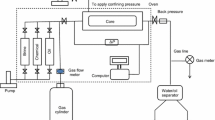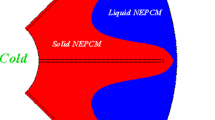Abstract
Effects of phase change specially steam condensation in enhanced oil recovery (EOR) processes such as steam assisted gravity drainage are a key important factor. Due to the last developments in nanotechnology, it is of great interest to use nanoparticles along with hot fluids to increase EOR efficiency. In current research, effects of phase change (steam condensation) on oil recovery from a two-dimensional porous medium during the injection of steam carrying alumina nanoparticles were studied. Additionally, fluid–fluid interfacial morphology development at different injection fluid temperatures i.e., 100, 110, 150, and 200 °C was examined. The governing equations of multi-phase fluid flow along with phase change were solved using finite volume computational technique. Comparing the results of oil recovery factor between phase change and non-phase change cases at 110 °C showed that initially the oil recovery factor in the case of non-phase change increases sharply, but as time goes on, the efficiency of phase change case becomes greater than that of non-phase change case mainly due to the large variations in fluid properties. It was also predicted that in injection of fluid at different temperatures, initially the recovery of oil grows sharply for 200 °C, but the final results of injected fluid with 110 °C achieves the highest efficiency of 67.5%. The final oil recovery at 110 °C increased by 21.5% compared to 200 °C. Moreover, the results predicted that the trend of oil recovery at different injection temperatures had a non-monotonic behavior over the time. Besides, the results showed that the amount of liquid water accumulation in the porous medium was reduced by increasing the injection temperature due to the low resident time and high energy content of the injected fluid at higher temperatures. Overall, the resident time of the injected fluid, its initial energy content (injection temperature), and phase change are the most vital factors in oil recovery factor enhancement.










Similar content being viewed by others
References
Green, D.W.; Willhite, G.P.: Enhanced oil recovery, p. 545. Henry L. Doherty Memorial Fund of AIME, Society of Petroleum Engineers, Richardson (1998)
Mozaffari, S.; Nikookar, M.; Ehsani, M.R.; Sahranavard, L.; Roayaie, E.; Mohammadi, A.H.: Numerical modeling of steam injection in heavy oil reservoirs. Fuel 112, 185–192 (2013)
Green, D.W.; Willhite, G.P.: Enhanced oil recovery, Vol. 6. Henry L. Doherty Memorial Fund of AIME, Society of Petroleum Engineers, Richardson (1998)
Lazar, I.; Petrisor, I.G.; Yen, T.F.: Microbial enhanced oil recovery (MEOR). Pet. Sci. Technol. 25(11), 1353–1366 (2007)
Wang, Z.; Liu, X.; Luo, H.; Peng, B.; Sun, X.; Liu, Y.; Rui, Z.: Foaming properties and foam structure of produced liquid in alkali/surfactant/polymer flooding production. J. Energy Res. Technol. 143(10), 103005 (2021)
Ahmadlouydarab, M.; Liu, Z.S.S.; Feng, J.J.: Interfacial flows in corrugated microchannels: flow regimes, transitions and hysteresis. Int. J. Multiph. Flow 37(10), 1266–1276 (2011)
Tang, Y.; Hou, C.; He, Y.; Wang, Y.; Chen, Y.; Rui, Z.: Review on pore structure characterization and microscopic flow mechanism of CO2 flooding in porous media. Energ. Technol. 9(1), 2000787 (2021)
Bera, A.; Babadagli, T.: Status of electromagnetic heating for enhanced heavy oil/bitumen recovery and future prospects: a review. Appl. Energy 151, 206–226 (2015)
Naqvi, S.: Enhanced oil recovery of heavy oil by using thermal and non-thermal methods. Dalhousie University, Halifax (2012)
Alvarado, V.; Manrique, E.: Enhanced oil recovery: an update review. Energies 3(9), 1529–1575 (2010)
Santos, R.G.; Loh, W.; Bannwart, A.C.; Trevisan, O.V.: An overview of heavy oil properties and its recovery and transportation methods. Braz. J. Chem. Eng. 31(3), 571–590 (2014)
Pratama, R.A.; Babadagli, T.: Effect of temperature, phase change, and chemical additives on wettability alteration during steam applications in sands and carbonates. SPE Reservoir Eval. Eng. 23(01), 292–310 (2020)
Alvarez, J.; Han, S.: Current overview of cyclic steam injection process. J. Pet. Sci. Res. 2(3), 116–127 (2013)
Alikhlalov, K.; Dindoruk, B.: Conversion of cyclic steam injection to continuous steam injection. In: SPE Annual Technical Conference and Exhibition. Society of Petroleum Engineers (2011)
Batycky, J.; Leaute, R.; Dawe, B.: A mechanistic model of cyclic steam stimulation. In: International Thermal Operations and Heavy Oil Symposium. Society of Petroleum Engineers (1997)
Liu, P.; Zheng, H.; Wu, G.: Experimental study and application of steam flooding for horizontal well in ultraheavy oil reservoirs. J. Energy Res. Technol. 139(1), 012908 (2017)
Pratama, R. A.; Babadagli, T.: Wettability state and phase distributions during steam injection with and without chemical additives: an experimental analysis using visual micro-models. In: SPE/IATMI Asia Pacific Oil and Gas Conference and Exhibition. Society of Petroleum Engineers (2019)
Wu, Z.; Liu, H.: Investigation of hot-water flooding after steam injection to improve oil recovery in thin heavy-oil reservoir. J. Pet. Explor. Prod. Technol. 9(2), 1547–1554 (2019)
Kong, X.; Ohadi, M.M.; Petroleum, T.; Xiangling, K.: Applications of micro and nano technologies in the oil and gas industry—overview of the recent progress. In: Abu Dhabi International Petroleum Exhibition and Conference, Abu Dhabi, UAE (2010)
Krishnamoorti, R.: Technology tomorrow: extracting the benefits of nanotechnology for the oil industry. J. Pet. Technol. 58(11), 24–6 (2006)
Yao, B.; Li, C.; Yang, F.; Sjöblom, J.; Zhang, Y.; Norrman, J.; Paso, K.; Xiao, Z.: Organically modified nano-clay facilitates pour point depressing activity of polyoctadecylacrylate. Fuel 15(166), 96–105 (2016)
Yousefvand, H.; Jafari, A.: Enhanced oil recovery using polymer/nanosilica. Proc. Mater. Sci. 11, 565–570 (2015)
Mokhatab, S.; Fresky, M.A.; Islam, M.R.: Applications of nanotechnology in oil and gas E&P. J. Pet. Technol. 58(04), 48–51 (2006)
Ehtesabi, H.; Ahadian, M.M.; Taghikhani, V.; Ghazanfari, M.H.: Enhanced heavy oil recovery in sandstone cores using TiO2 nanofluids. Energy Fuels 28(1), 423–430 (2013)
Rostami, P.; Sharifi, M.; Aminshahidy, B.; Fahimpour, J.: The effect of nanoparticles on wettability alteration for enhanced oil recovery: micromodel experimental studies and CFD simulation. Pet. Sci. 16(4), 859–873 (2019)
Gharibshahi, R.; Jafari, A.; Ahmadi, H.: CFD investigation of enhanced extra-heavy oil recovery using metallic nanoparticles/steam injection in a micromodel with random pore distribution. J. Petrol. Sci. Eng. 174, 374–383 (2019)
GhanadDezfully, M.; Jafari, A.; Gharibshahi, R.: CFD simulation of enhanced oil recovery using nanosilica/supercritical CO2. In: Advanced Materials Research (Vol. 1104, pp. 81–86). Trans Tech Publications, London (2015)
Maghzi, A.; Mohammadi, S.; Ghazanfari, M.H.; Kharrat, R.; Masihi, M.: Monitoring wettability alteration by silica nanoparticles during water flooding to heavy oils in five-spot systems: a pore-level investigation. Exp. Thermal Fluid Sci. 40, 168–176 (2012)
Jafari, A.; Zamankhan, P.; Mousavi, S.M.; Pietarinen, K.: Modeling and CFD simulation of flow behavior and dispersivity through randomly packed bed reactors. Chem. Eng. J. 144(3), 476–482 (2008)
Lee, W. H.: A pressure iteration scheme for two-phase modeling. Technical Report LA-UR 79-975. Los Alamos Scientific Laboratory, Los Alamos, New Mexico (1979)
Author information
Authors and Affiliations
Corresponding author
Ethics declarations
Conflict of interest
All authors declare that they have no conflict of interest. All authors confirm proper acknowledgements to other works have been given, quotation marks are used for verbatim copying of material, and permissions secured for material that is copyrighted.
Rights and permissions
About this article
Cite this article
Ahmadlouydarab, M., Ghaffari, K. & Jafari, A. Effects of Phase Change on Enhanced Oil Recovery During Injection of Steam Carrying Alumina Nanoparticles: Numerical Simulation. Arab J Sci Eng 47, 11135–11144 (2022). https://doi.org/10.1007/s13369-021-05738-w
Received:
Accepted:
Published:
Issue Date:
DOI: https://doi.org/10.1007/s13369-021-05738-w




